Images & Movies
Movies
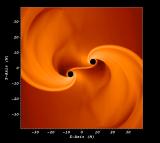 Formation and Coalscence of Supermassive Black Hole Binaries in Supermassive Star Collapse
Formation and Coalscence of Supermassive Black Hole Binaries in Supermassive Star Collapse
Collapse of a rapidly differentially rotating supermassive star with a tiny initial m=2 density perturbation. The star is unstable to the non-axisymmetric m=2 mode, collapses, and forms two black holes. The nascent black holes subsequently inspiral and merge under the emission of powerful gravitational radiation. The collapse is accelerated by a ~0.25% reduction in the adiabatic index Gamma, motivated by electron-positron pair production at high temperatures. Simulation from Phys. Rev. Lett. 111, 151101. [Credits: C. Reisswig]
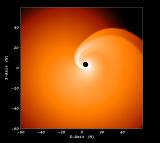 Supermassive Star Collapse, m=1 initial density perturbation
Supermassive Star Collapse, m=1 initial density perturbation
Collapse of a rapidly differentially rotating supermassive star with an initial m=1 density perturbation. The star forms a single off-centered fragment which collapses to a black hole. Simulation from Phys. Rev. Lett. 111, 151101. [Credits: C. Reisswig]
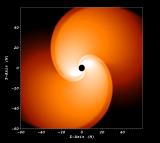 Supermassive Star Collapse, m=2 initial density perturbation
Supermassive Star Collapse, m=2 initial density perturbation
Collapse of a rapidly differentially rotating supermassive star with an initial m=1 density perturbation. The adiabatic index Gamma is held fixed at 4/3. The star forms two orbiting fragments. A run-away collapse occurs at the center of the star, leading to the formation of a single black hole. Simulation from Phys. Rev. Lett. 111, 151101. [Credits: C. Reisswig]
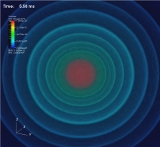 Black hole formation: density profile
Black hole formation: density profile
A volume rendering of the fluid density of a collapsing 75 M_sol star. Core bounce occurs at t = 0 ms. Approximately 68 ms after bounce, the nascent protoneutron star is unable to withstand the gravitational pull of its own mass. Gravitational collapse sets in and a black hole is formed. Surrounding material is beginning to hyperaccrete onto the black hole when the simulation stops. A long term goal is to be able to follow the entire hyperaccretion phase until a stable accretion disk around the black hole is formed. This is a possible model for the central engine of long gamma-ray bursts. Simulation from Phys.Rev.Lett.106:161103,2011. [Credits: C. Reisswig, C. D. Ott]
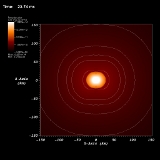 Black hole formation: 2D density profile
Black hole formation: 2D density profile
A 2D pseudo-color rendering of the fluid density of a collapsing 75 M_sol star. See description above. Simulation from Phys.Rev.Lett.106:161103,2011. [Credits: C. Reisswig, C. D. Ott]
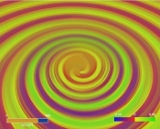 Binary black hole merger: dynamics and emitted gravitational radiation
Binary black hole merger: dynamics and emitted gravitational radiation
Dynamics of the inspiral, merger and ringdown of an equal-mass spin-aligned binary black hole coalescence. The colorful spiral pattern is the Weyl scalar psi4 indicating the emitted gravitational radiation. Since the two spins are aligned with the orbital angular momentum, but different in magnitude, the radiation is asymmetric and there is a preferred direction of radiated linear momentum. The merger remnant is thus “kicked” to the opposite direction. In this particluar case the “kick” is rather weak. It is only v_kick = ~25 km/s. Simulation fromPhys.Rev.D76:124002,2007. [Credits: R. Kaehler, C. Reisswig, L. Rezzolla]
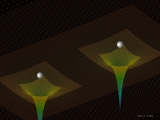 Binary black hole merger: moving grids and apparent horizons
Binary black hole merger: moving grids and apparent horizons
Dynamics of the inspiral, merger and ringdown of an equal-mass spin-aligned binary black hole coalescence. Simulation from Phys.Rev.D76:124002,2007. [Credits: C. Reisswig]
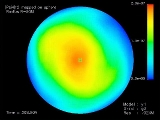 Binary black hole merger: asymmetry in emitted radiation
Binary black hole merger: asymmetry in emitted radiation
The absolute square of Psi4 projected onto a spherical 2-surface seen from above down along the z-axis perpendicular to the orbital plane. This binary black hole configuration has equal masses with spins that are aligned with the orbital angular momentum and equal in magnitude, but opposite in direction to each other. This generates an asymmetry in the radiation which can be seen in the movie. If the radiation was symmetric, the color pattern would be spherically symmetric as well. Asymmetric radiation leads to a recoil imparted to the center of mass of the system. In particular, the merger remnant will obtain a “kick”. In this particular case, the kick velocity is v_kick ~ 225 km/s. Simulation fromPhys.Rev.D76:124002,2007. [Credits: C. Reisswig]
Images
 Grid setup: Binary black hole merger
Grid setup: Binary black hole merger
This image shows the central region around two orbiting black holes. Depicted are the two apparent horizons and a 2d z=0 slice of the lapse gauge function. A hierarchy of refined grid boxes surrounding each horizon is visible. Simulation fromPhys.Rev.D76:124002,2007. [Credits: C. Reisswig]
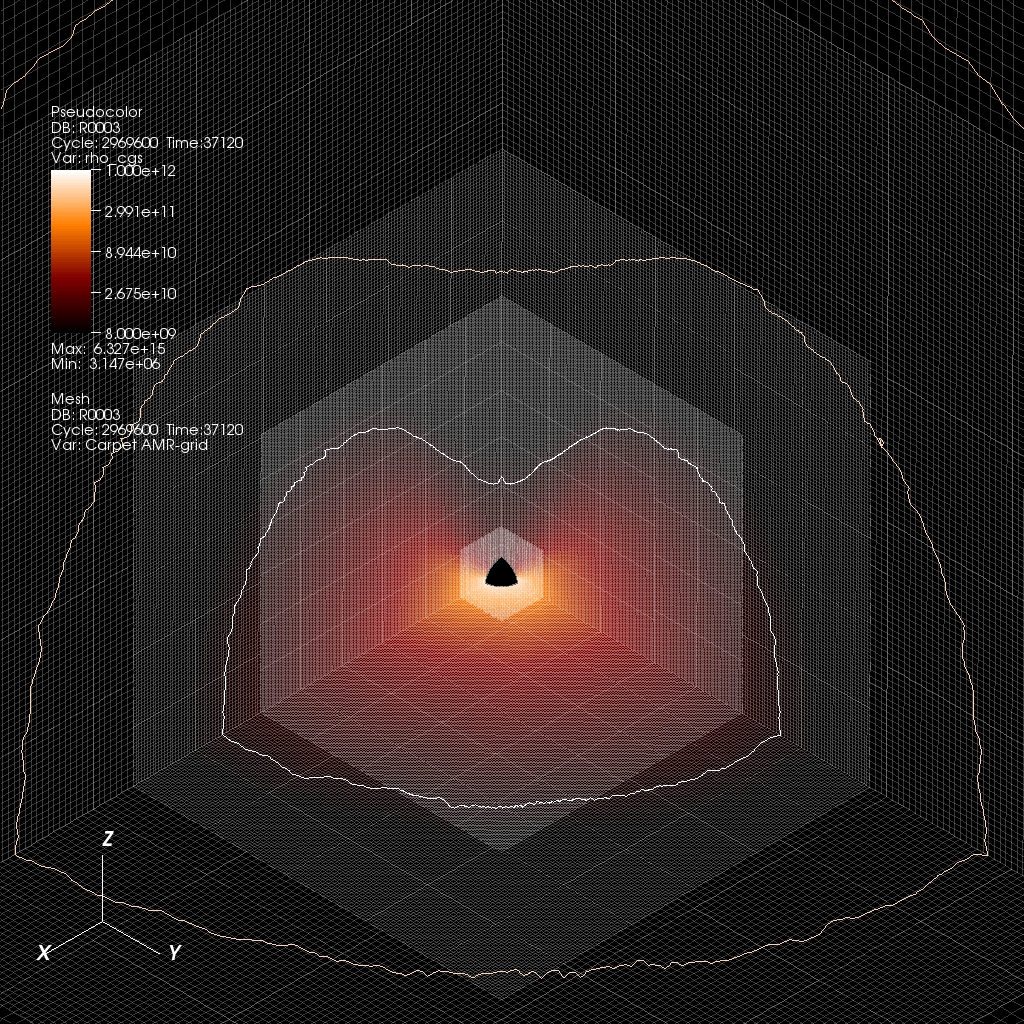 Grid setup: Core collapse and black hole formation
Grid setup: Core collapse and black hole formation
This image shows the central region around a collapsed stellar core in the hyperaccretion phase. The black surface is the aparent horizon. The density profile is indicated by red colors. In addition, contour lines of additional density values are visible. Simulation from Phys.Rev.Lett.106:161103,2011. [Credits: C. Reisswig and C. D. Ott]
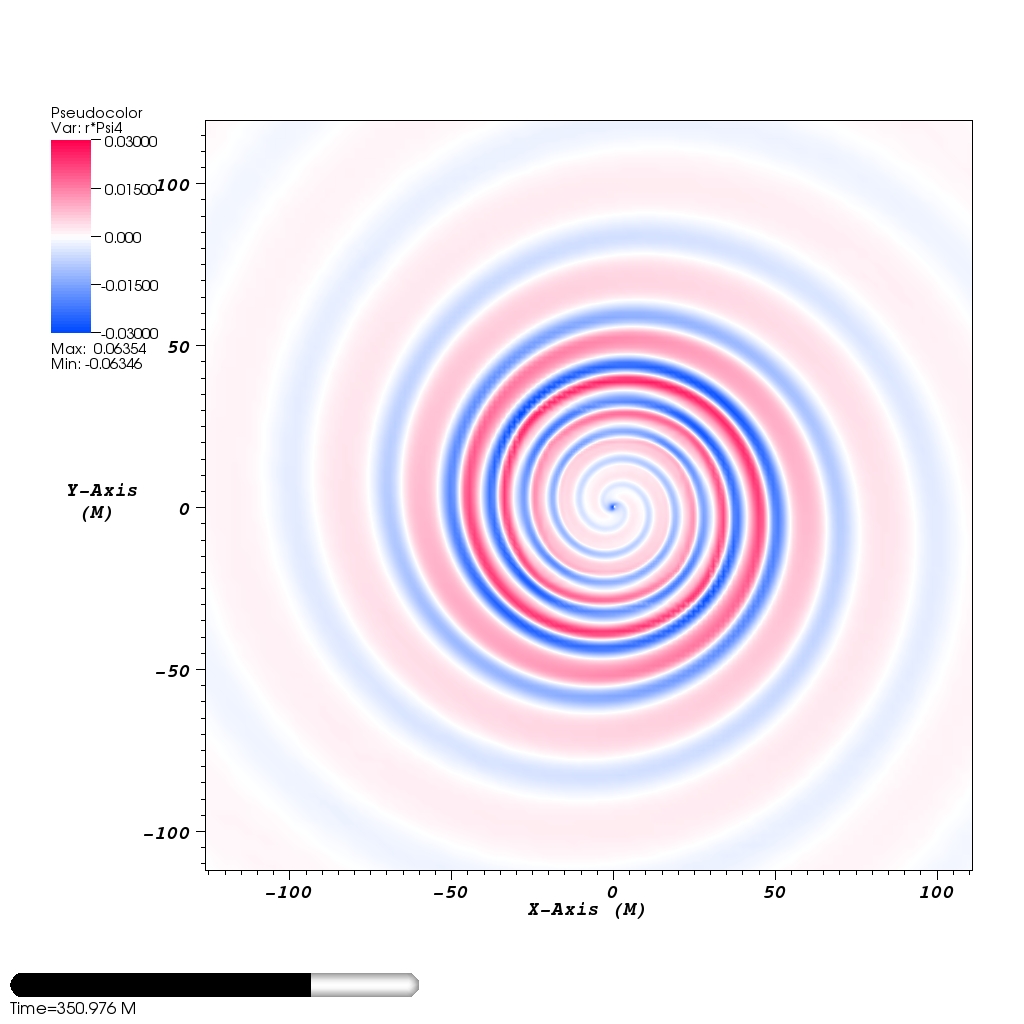 Binary black hole merger: Emitted gravitational radiation
Binary black hole merger: Emitted gravitational radiation
Gravitational radiation (psi4) emitted in the orbital plane of an equal-mass spin-aligned binary black hole merger. The two black holes are at the center of the image, however, too small to be seen at this scale. Since the radiation is slightly asymmetric in this particular case (effect too small to be visible), we have non-zero net linear momentum. The outcome is a “kicked” merger remnant. Simulation fromPhys.Rev.D76:124002,2007. [Credits: C. Reisswig]
Binary black hole merger: Deformed cylinder
How would a cylinder look like if a gravitational wave from a binary black hole merger would be traveling along its z-axis? The cylinder would be deformed by the plus (blue) and cross (orange) polarization states of the circularly polarized gravitational wave. The rendering in the image greatly exeggerates this effect. The gravitational wave is traveling along the direction perpendicular to the orbital plane further into the image (z-axis). The cylinder is aligned with the same axis and the gravitational wave is currently standing in the cylinder. Since a gravitational wave is transversal, it deforms the cylinder in the x and y direction. The merger results in a peak amplitude of the deformation. The ring-down is visible at the left while the inspiral is visible to the right. The gravitational radiation used to make this image was extracted at future null infinity: Phys.Rev.Lett.103:221101,2009. [Credits: C. Reisswig]

